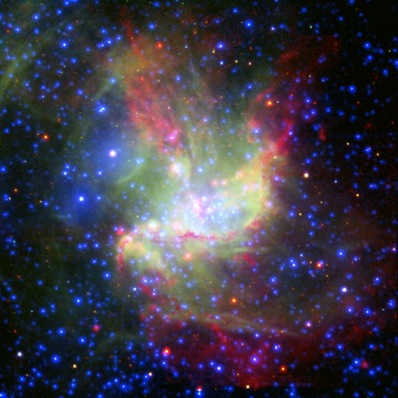
Magnetic fields sculpt
stellar growth
DR EMILY BALDWIN
ASTRONOMY NOW
Posted: September 10, 2009


New research shows that cosmic magnetic fields play a more dominant role in star formation than previously believed.
Star formation demands that giant clouds of gas and dust collapse inward under the influence of gravity, growing denser and hotter until nuclear fusion is triggered, giving rise to the birth of new stars. Yet only a small fraction of a cloud's material spawns stars.
 New research provides strong evidence that magnetic fields dominate turbulence in star birth. This image shows star formation in NGC 346, the brightest stellar nursery found in the Small Magellenic Cloud. Image: NASA/JPL-Caltech/ESA/ESO/MPIA.
New research provides strong evidence that magnetic fields dominate turbulence in star birth. This image shows star formation in NGC 346, the brightest stellar nursery found in the Small Magellenic Cloud. Image: NASA/JPL-Caltech/ESA/ESO/MPIA.
Magnetic fields and turbulence in the gas clouds are both thought to hinder the gravitational collapse in varying amounts. While magnetic field lines channel flowing gas into distinct directions, turbulence stirs it around and induces an outward force that resists collapse.
Research lead by Harvard-Smithsonian Center for Astrophysics astronomer Hua-bai Li says that the relative importance of magnetic fields versus turbulence is a matter of much debate. "Our findings serve as the first observational constraint on this issue," he says.
Li and colleagues studied 25 'cloud cores', dense patches of material on the cusps of being transformed into stars, located within molecular clouds up to 6,500 light years from Earth. By studying the polarised light emitted by these cores, the magnetic fields could be measured and compared with the fields in the surrounding tenuous nebulae.
The result had a very clear conclusion: since the magnetic fields were observed to line up in the same direction despite the relative size scales (one light year cores versus 1,000 light year nebulas) and relative densities, and since turbulence would be expected to churn up the magnetic fields into different directions, magnetic fields must therefore reign as the dominant property in counter-acting gravitational forces during star birth.
"Our result shows that molecular cloud cores located near each other are connected not only by gravity but also by magnetic fields," says Li. "This shows that computer simulations modelling star formation must take strong magnetic fields into account."
The new result, which has been accepted for publication in The Astrophysical Journal, will add vital pieces to the puzzle of how our Universe came to look the way it does today.
|



